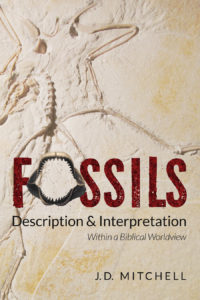MORE EVIDENCE AGAINST UNIFORMITARIANISM AND FOR CATASTROPHE!
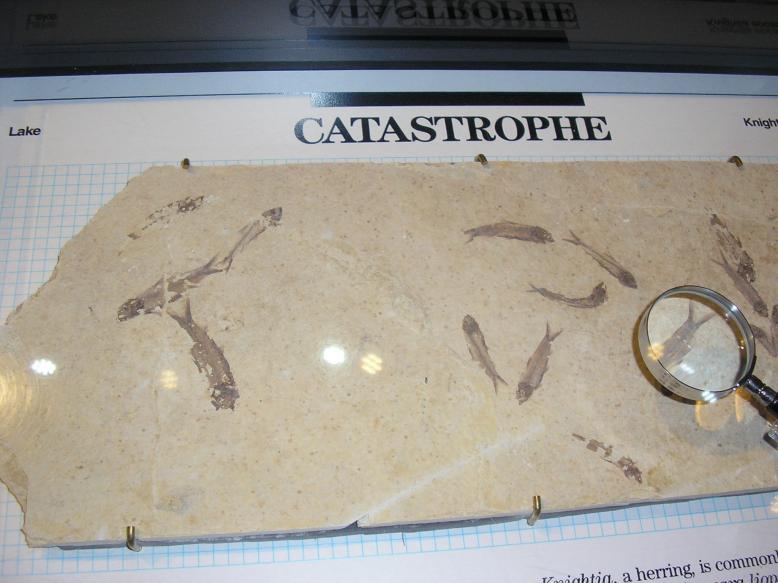
In the limestone sedimentary layers of the Green River Formation near Kemmerer, Wyoming are found millions upon millions of fossils. They consist mostly of fossil fish caught in what is agreed by both evolutionists and creationists to be some sort of catastrophe.

The fossils found in this area in Southwest Wyoming can bring hundreds or thousands of dollars depending on the type and quality of the fossils. Evolutionist fossil hunters also take advantage of the supposed old age of the fossils (40 million years) in order to attempt to increase their value to prospective buyers.

Most of the fish found fossilized in the limestone matrix in this area are herring or perch types of fish. This two-fish fossil slab cost $20.00 retail in June, 2009.

Most of the fossils found at Fossil Lake Quarry near Kemmerer, WY are discovered, retrieved and prepared by professional fossil hunters. These people make a living by finding, preparing and selling these fossils to collectors and museums all over the world.

Sometimes in the search for fossils, the limestone slabs split conveniently so that half of the fish is on the “main slab” and the other half is on the “counter slab” of the fossil, as in this case. (J.D. & Bonnie fossil)

This is another of the fossil fish discovered and then prepared by J.D. and Bonnie in June of 2009.

This photo and the next two are all of the same limestone slab in the quarry. In this photo J.D. has started a crack in the edge of the slab by driving a thin steel tool into its center edge. Notice that the crack did not propagate from where J.D. drove the tool and also notice that the crack did not propagate perfectly.

By forcing the tool deeper into the slab, J.D. was able to get the slab to split into two pieces. Whether or not there is a fossil to be found is pure potluck, however.
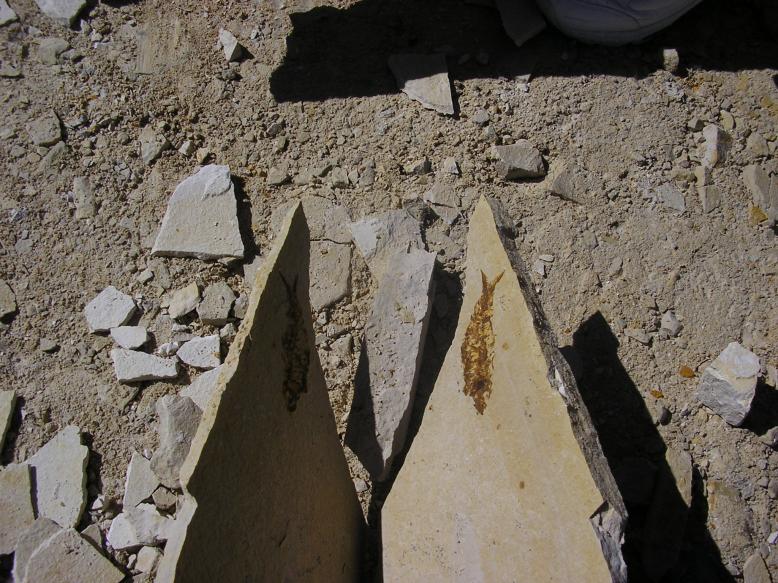
In this particular case, J.D. was fortunate and got the slab to split almost directly through the center of the fish fossil. Usually one has no idea where the fossils are in the limestone. Sometimes one can even see evidence of a fossil at the edge of a slab, but that does not mean it will be possible to get the limestone slab to split on a plane so it can be recovered.

A view of the area in the quarry where Bonnie and J.D. dug for fossils near Kemmerer, WY in June, 2009.

Bonnie at work splitting a limestone slab in her search for fossils.

The professional fossil hunters use varying methods for organizing their quest for effective and efficient recovery of fossils. Some of the slabs shown here are in storage for later splitting and some are on edge to allow them to dry in the sun prior to the splitting process. Other slabs are ready for final preparation back at the respective hunter’s laboratory or shop.

An amazing find in the quarry was the large number of exploded fish that are encased in the limestone layers. The first fossil that Bonnie found was an exploded fish. Most hunters would discard these fish as worthless due to their ignorance of their significance. J.D. and Bonnie kept three of these exploded fish to show as examples of rapid complete burial of the fish. These exploded fish are reinforcers of the creationist catastrophic view and speak against uniformitarianism and millions of years in the rock record at Fossil Quarry.

This is a close-up view of one of the exploded fish. Experiments and observations of dead fish of today have resulted in the conclusion that they decay within days (or weeks at most) after death.

Another exploded fish fossil. J.D. and Bonnie also found lots of fish coprolites in the limestone. These coprolites are another thing that most of the fossil hunters discard or dig out as being worthless. But, these fish coprolites are an even better evidence of rapid burial than the exploded fish. This is because fish faeces has been determined by experiment to decompose in about one day. Therefore, the fish faeces must have been preserved in the limestone within 24 hours.

Here is a photo of a professional fossil hunter by the name of David. J.D. spoke with him at some length and learned quite a lot about the Green River fossil excavation business. David was extremely organized and very experienced. He has been a professional since he was a teenager and each year he purchases an area of the quarry from the quarry owner for about $10,000. Due to the extreme winters in this area of Wyoming, he is able to work at the quarry only from the first of June through October. In the first month he says he will normally discover, prepare and sell enough fossils to pay off his initial investment.

In this photo David displays his arms onto which he has tattooed all of the different kinds of fossils he has found, including, he says, sting rays, turtles, bats, birds, plants and, of course, numerous fish. On the hood of his truck are displayed the fossils that he had found on the morning of the interview in June of 2009.

Another look at David’s section of the limestone split fish quarry.

This photo and the next two illustrate the preparation process that J.D. used after he got back home with the recovered limestone slabs and the fish fossils. This is a photo of the main slab of a fossil fish in which the majority of the fossil is still covered in limestone. That is, the slab in this case split along a plane which was along one side of the fish rather than through the middle of the fish.

The process for uncovering the fish is to use a small, sharp pointed steel tool as shown here to carefully remove the limestone from the top of the fossil. To remove the limestone J.D. used a small circular motion to slowly disintegrate the covering limestone and then he blew the resulting dust away. In this photo some progress has been made in the process. Even with the utmost care some of the fossil surface is lost as the tiny pieces of limestone that are caused to disintegrate carry some of the fossil away with them.

Here is the completed preparation of this 5-inch-long fossil fish. It took J.D. about an hour to complete the process for this particular fossil. Since the matrix material was almost pure limestone it was relatively easy to uncover. In cases where the fossils are encased in harder material such as shale it can take much longer even with the best available professional tools and techniques.

This is a photo of the counter slab for the fish fossil shown previously. All that existed in this counter slab was a faint imprint of one side of the fish. If J.D. had attempted any excavation on the counter slab for this fossil, he would have destroyed totally any evidence of the fish fossil in that part.

Notice (as in this photo) that in the plan view of most of these limestone slabs that the slabs break in very irregular shapes. Professional preparers often use a rock saw blade in a table saw to square up the slab as shown in the earlier photo of the $20 fossil. (J.D. & Bonnie fossil)

This photo shows the irregular cleaving pattern of the limestone which results in the characteristic “jagged” edges typical with sedimentary rocks. (J.D. & Bonnie fossil)

This photo and the next two photos demonstrate the difficulty in getting complete fossils out of the limestone slabs. The fossil hunter has little control over where the limestone will split or break with relation to the fossils hidden within. (J.D. & Bonnie fossil)

Other than the missing tail this fossil is a very fine specimen. (J.D. & Bonnie fossil)

This specimen has some fish coprolites visible along the slab lower edge. (J.D. & Bonnie fossil)

Fossil hunters from all over the world come to get fossils from the Wyoming quarries. This section of Quarry F2 was being “mined” by a professional from Germany.
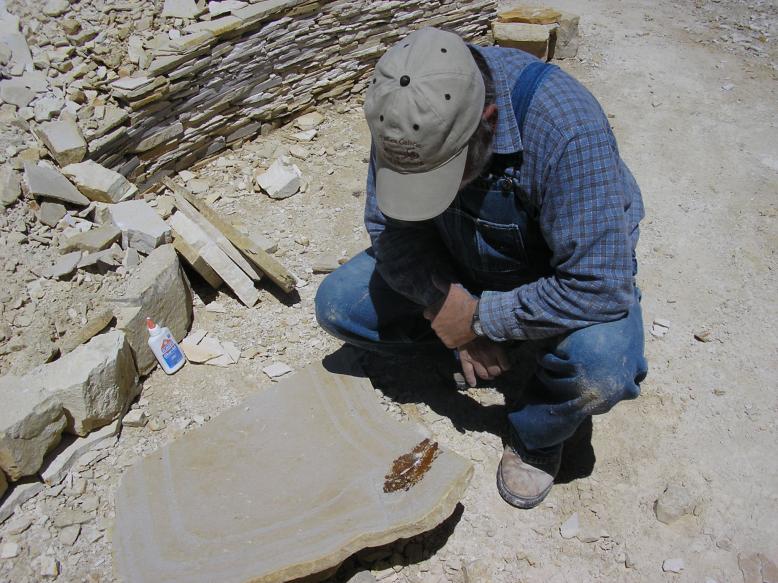
As shown in previous photos, the limestone doesn’t give up its fossil treasures easily. Here Elmer’s glue is being used by the German to reassemble the pieces of a nice fossil fish. Notice how the hunter in this section has meticulously built a separator wall out of remnant pieces of limestone.

A closer view of the Elmer’s glue repair. The tip of the tail of this fossil fish is still missing, however.
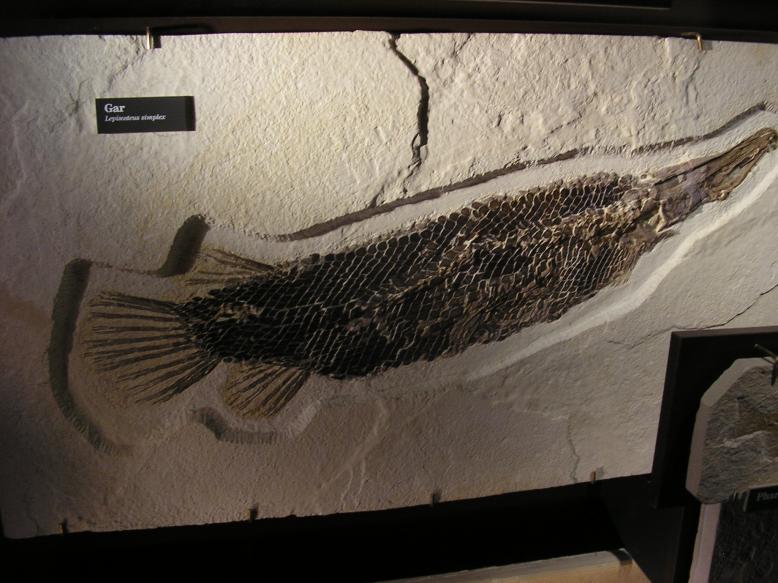
Not all of the fish found in the quarries are small herring or perch. This is a four or five foot long Gar fish fossil which was on display at the Fossil Butte National Monument museum just outside Kemmerer, Wyoming.

This is another Gar fish fossil which was on display at Ulrich Studios just outside the Fossil Butte Monument. It measured 5′-4″ long and may look flat in this photo, but it is not. The fossil is 3-dimensional and up to about one inch thick. Uniformitarians believe that the 18″ thick sedimentary layer where this fish was recovered was laid down at the rate of 0.0045 inch per year. That would mean that it would take 220 years for the sediment varves to cover this entire flattened fish. This is not reasonable and speaks against the uniformitarian principle and for total abrupt burial instead.
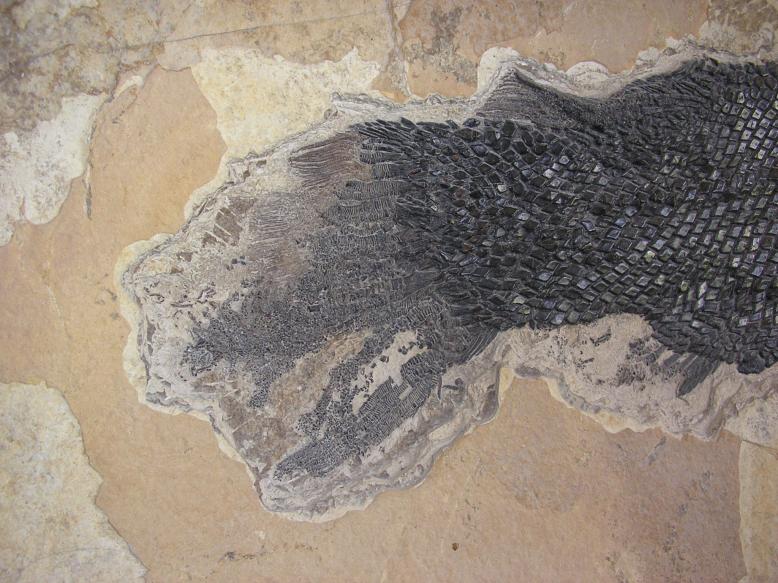
This is a close-up photo of the tail of the Ulrich Gar fish in an attempt to better show the 3-dimensional thickness of the fish fossil.

At the Fossil Butte National Monument Museum were displayed some other (less common) fossils that have been found in the Green River Formation. In this photo can be seen a cattail head, some berries, a leaf, a flower, a March fly, a dragonfly and a seedpod. Most of the non-fish fossils at the museum were not real fossils but cast replicas of the fossils due to the value and scarcity of the non-fish fossils.

This is a replica cast of a Green River Formation (Fossil Lake) snake fossil.

A replica cast of a turtle fossil at Fossil Butte. As is usual with all secular museums in most of the world, all of the fossils in this museum were interpreted using uniformitarianism, millions of years and the evolutionary philosophy.

J.D. and Bonnie traveled in June, 2009 to Utah and Wyoming to visit five museums in the area, to study the geology and paleontology of the area and to dig for fossils in the Fossil Lake limestone. A large part of the motivation for the trip for J.D. was to study bird fossils as they related to his investigation of “Archaeopteryx — What Was It?” (DVD of his presentation of the same title is now available.) What they found in their search was that fossil bird skeletons and feathers are indeed very rare. This photo is of a cast of one of the half dozen or so fossil birds that they were able to find in the museums. This bird was displayed at Fossil Butte National Monument Museum.

This is a photo of a cast of a fossil bat also at Fossil Butte Museum near Kemmerer, Wyoming.

A cast of an unidentified bird at Fossil Butte NM museum. This crane-type of bird had a skeleton length from the tip of the foot to the tip of its beak of about 11 inches. None of the bird skeletons on display at any of the museums had any associated noticeable feathers or feather imprints. This was an indication of the rarity of fossil feathers especially in association with bird skeletons and also was evidence which strengthened the position of some creation scientists who believe that Archaeopteryx was and is a fraud.

Here is a photo of the remaining bird fossil casts which were on display at Fossil Butte Museum.

A close-up of the bird skeleton in the previous photo where about half of the bird’s structure was fossilized in the matrix.
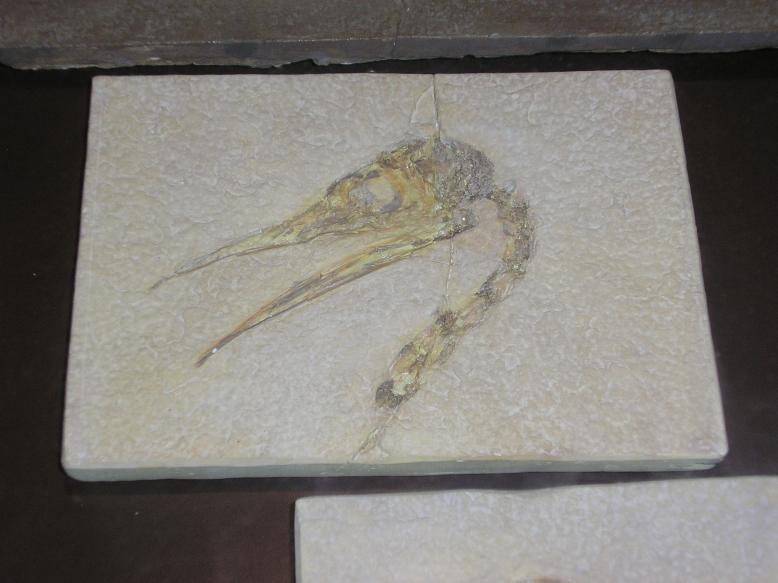
This is a close-up photograph of the half slab for the skull and vertebrae of the bird also shown above. It is important to understand that fossil cast replicas are not identical to the actual fossils; much of the detail is lost in the casting process and the resulting casts often exhibit the artistic license of the cast maker. For example, the casts usually do not represent the actual color of the original bones and matrix and they cannot easily capture the situation regarding the complexity of the fossil matrix composition.

This is a photo of a cast of a fossil found in the Green River Formation by fossil hunter Jim Tynsky and on display at his fossil shop in downtown Kemmerer, Wyoming. The original fossil was sold to the Field Museum of Natural History in Chicago, IL. The fossil is identified as a 3-toed horse by evolutionists and is about four feet long. Notice the fossil fish which are also preserved in the matrix along with the “horse.”

This photo is a close-up of the bird skeleton replica in the upper left corner of the earlier photo at Fossil Butte Museum. The bird is identified as Gallinuloides wyomingensis and is available to the general public as a cast replica from several cast sellers on the internet. (J.D. has one of these replica birds in his fossil collection.)

This is a close-up photo of a fossil feather on display at Fossil Butte Museum. If it is an authentic feather it is a plumage feather since all living FLYING bird feathers are asymmetrical with the vane on one side of the shaft larger than the vane on the other side of the shaft. This feather is obviously symmetrical.
J.D. Mitchell
For more information on fossils get my book:
